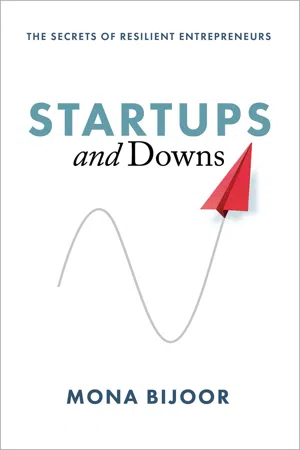
- 130 pages
- English
- ePUB (mobile friendly)
- Available on iOS & Android
About This Book
Entrepreneurship is a cycle of failures and recoveries-hopefully with more successes than not.This national bestseller is about resilience and navigating the process.How do the best entrepreneurs think about failure-as it's happening and in hindsight-and ultimately win? Today's media is replete with stories about major entrepreneurial successes, IPOs (initial public offerings), mergers, and acquisitions. Reporters and readers alike have also been captivated by the stories of entrepreneurial failures, downfalls, and massive exits (think Travis Kalanick, Elizabeth Holmes, and Doug Evans). However, entrepreneurship is rarely linear, and a lot happens between the headlines and reality. Entrepreneurship is a cycle of failures and recoveries—hopefully with more successes than not.Start-Ups and Downs: The Secrets of Resilient Entrepreneurs shares the wisdom of one entrepreneur who successfully disrupted an entire industry but felt as if she was never prepared for what came next. Mona Bijoor has created a guidebook for navigating the process, from pitching with power to coping with competition, with inspiring stories from respected entrepreneurs, including Nat Turner, cofounder and CEO of Flatiron Health; Courtney Nichols Gould, founder and co-CEO of SmartyPants Vitamins; and Stephen Kuhl, cofounder and CEO of Burrow, intended to lift up anyone determined to keep pushing forward.This book is about resilience. How do the best entrepreneurs think about failure—as it's happening and in hindsight—and ultimately win?
Frequently asked questions
Information
| Vision (Your Destination or Dream) | Strategy (Goals to Your Vision) | Tactics (Your Actions) |
| Become the world’s leading natural producer of premium food products and best-in-class services that exceed our customers’ tastes and desires. | Year 1 to Year 3: Get known for having the best-in-breed products made at the best manufacturing facilities in North America. |
|
| Year 4 to Year 7: Purchase farms to grow organic, pesticide-free ingredients, and expand product line to include three to four new categories. |
| |
| Year 7 to Year 10: Open own stores in twenty-five cities that exclusively sell our branded product. |
|
- The first five to ten tactics are generic—some tactics will work, and some will not because they are stale ideas.
- Creativity really comes when you push yourself to come up with as many tactics as you can—to go beyond what is comfortable when brainstorming.
- The Pareto Principle truly applies to this exercise: 20 percent of the tactics listed will allow you to achieve at least 80 percent of your strategic goal.
Table of contents
- Introduction
- The Mind-set of an Entrepreneur
- Raising Capital Is Fun (Said No One Ever)
- No Means Not Right Now
- Have a Go-To Market Strategy or Go Home
- Tough-Loss Recovery: Losing Key Team Members
- Building Team Resilience
- Foundational Issues: There Is No Such Thing as a Shortcut
- Can’t Sleep at Night? Maybe It’s the Competition
- Losing Your Job: Wait, I’m the Founder!
- Sacrifice for What?
- Parting Thoughts
- About The Author